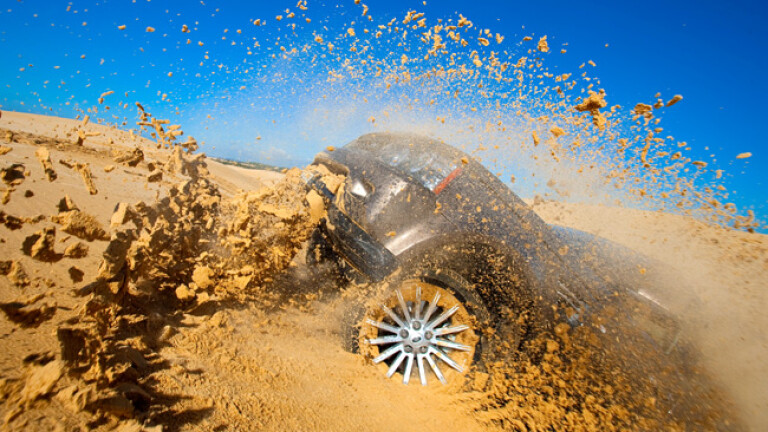
We rate how well the new players can look forward to their bush future.
No duds here. That’s the collective summary of the 2009 4X4OTY contenders after our judges ran critical eyes and rode analytical butts over five days of arduous testing. As usual, we started with a session on a hoist.
Having three mature chassis designs (or two, if you see the Range Rover Sport’s as a mildly-modified Disco 4) and one lightly revised layout (Prado), meant there weren’t any significant structural changes to pontificate about this year. In other words, each vehicle has had the wrinkles ironed out. Or has it?
The Prado, Disco and Rangie are all separate, body-on-chassis designs. To call them traditional somehow taints them, and only the Prado retains an old-school solid-axle rear. Located on upper and lower control arms and suspended by coils, or airbags on the Kakadu, it’s a simple, durable set-up that provides good ground clearance and suspension travel.
Up front, the basic layout is the same as for the previous model Prado (independent with coil springs) but with the KDSS system introduced on Kakadu and, more importantly, traction/stability control on all models, which is a great preventer of driveline breakages in inexperienced hands. The radiator and sump are well protected for a showroom stocker and the Prado intercooler’s new location, despite being in front of the radiator, is a long way from potential damage.
However, the Prado Kakadu’s rear air spring rates are evidently too soft and the punishment experienced by the bumpstops during the test can put enormous stresses into the chassis. The Prado GXL didn’t exhibit this trait.
Inside, the Prado shows exemplary fit and finish that bodes well for long-term toughness. There are no squeaks or sizzles from any of the cabin plastics and, although flat and loaded with luggage for our test, the new rear seats won’t wiggle around like the old ones.
A bonus for those who intend to add equipment is the fact that there are wiring harness blanks on the firewall to allow DIY driving light/radio installation without compromising cabin dust sealing. A drawback is that the Kakadu’s multiple external cameras might cop a flogging off-road, and we’re not sure yet if an aftermarket bullbar will impede the front camera’s view.
Our team has heard of more smashed Toyota diffs than Land Rover suspension failures but still some punters point to the Land Rover’s air suspension as being a weak link. So, there’s a question of trust there, but there’s no doubt the rest of the hydro-formed chassis and its suspension — a mix of cast/forged and fabricated components — is nothing less than bombproof.
Sensible spring and damper rates with long suspension travel take it easy on the chassis and body and all lines, sensors and wiring are positioned (usually) behind the solid bits and tethered to just about eliminate the risk of damage.
However, the automatic ride-height lowering to highway level at 40km/h is a frustration as it places the underbody closer to damaging terrain. It would be great if the software could be altered for Australia, where higher speeds are common over furrowed tracks.
High-kay Disco 3s used in arduous terrain have exhibited some ball-joint and tie-rod wear; Land Rover has upgraded these components for Disco 4. And with the fundamentals of the chassis identical, the fix fits D3, too.
The D4’s integral tow package is a stunning piece of design. As it’s standard (so no departure angle compromises), no-one can get the fit wrong and the removable tow hitch places its rated 3500kg straight into the chassis.
The Pajero’s chassis is a monocoque with independent front and rear suspension bolted direct to it, and by design it lacks the layer of void and the chassis/body rubbers of a separate chassis execution.
Mitsubishi has worked hard over the years to minimise NVH levels but the more direct noise path means Pajero is busier for passengers than the other vehicles here. That’s not a real pointer to toughness but perception can go a long way with the showroom buyer.
Thankfully, nothing stopped progress — as happened in the previous two years’ tests — but there were a couple of breakages. The benchmark Pajero first flung us a faux pas with its tailgate strut snapping. It’s a problem a few of the 4X4 judges have seen before; forget to disengage the strut’s locking mechanism and ka-ching!
Ron Moon also pointed out (after his 30,000km test) the vulnerability in the Pajero’s rear aircon. Installed under the driver’s side rear, it’s odds-on to be belted or crunched, rendering the aircon inoperable. Also, the Pajero’s rear bumper can be dislodged or torn off during careless dune crossings, as can the Prado’s. The Rangie and Disco remained damage free. Thank heavens.

COMMENTS